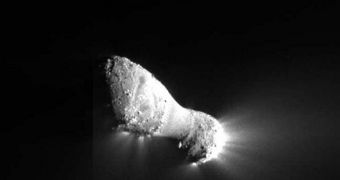Yesterday, November 4, the EPOXI spacecraft operated by the American space agency flew close to the surface of the Comet Hartley 2, collecting images as it went along, and providing experts with new insight into how the space object looks and behaves like.
The point of closest approach was reached at 10 am EDT (1400 GMT) Thursday, when the probe passed some 700 kilometers away from the surface of the comet.
Some of the most important traits that were analyzed included the volume of the body, as well as an analysis of the material spewing from its surface, and into space.
Some of the images that were snapped during the close flyby have already been beamed back to Earth through the Deep Space Network (DSN), and researchers who had a chance to look at them say that new data are definitely contained within.
“Early observations of the comet show that, for the first time, we may be able to connect activity to individual features on the nucleus,” says researcher Michael A'Hearn.
“We certainly have our hands full. The images are full of great cometary data, and that's what we hoped for,” adds the University of Maryland professor, who is also the principal investigator of EPOXI.
The mission operates the Deep Impact spacecraft, which has already studied the comet Temple 1 back in 2005. While in mid-flight, the probe was redirected to meet up with Hartley 2, while also conducting planetary studies at the same time.
After spending months on its chase, and covering several million miles, EPOXI finally managed to catch up with its target recently, and began imaging its nucleus at 5 pm EDT (2100 GMT) on November 3, NASA reports.
“The spacecraft has provided the most extensive observations of a comet in history,” explains Ed Weiler, the associate administrator of the NASA Science Mission Directorate (SMD)
“Scientists and engineers have successfully squeezed world class science from a re-purposed spacecraft at a fraction of the cost to taxpayers of a new science project,” adds the expert. The SMD is based at NASA Headquarters, in Washington DC.
The official adds that the mission control team at the Jet Propulsion Laboratory, in Pasadena, California, was able to take the spacecraft to about 435 miles above the surface of the comet.
This was an achievement all on its own, considering how much the body wobbles, and how fast it zips towards the Sun.
This “is a testament to our team's skill that we nailed the flyby distance to a comet that likes to move around the sky so much,” explains JPL EPOXI mission manager Tim Larson.
“While it's great to see the images coming down, there is still work to be done. We have another three weeks of imaging during our outbound journey,” he adds.

 14 DAY TRIAL //
14 DAY TRIAL //